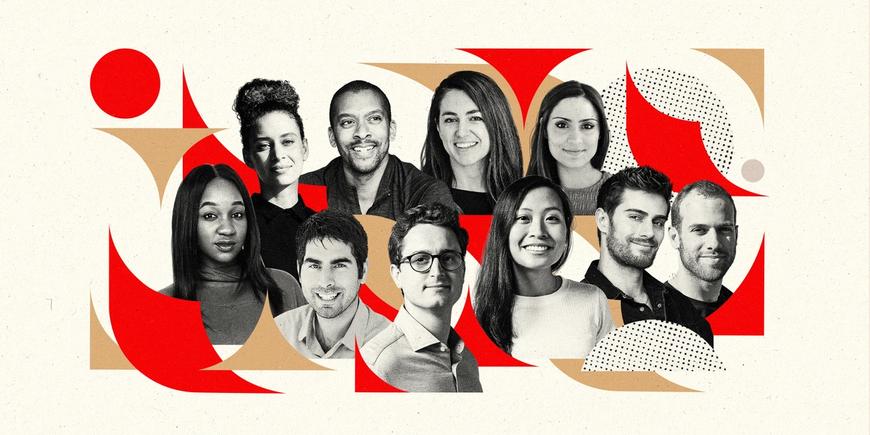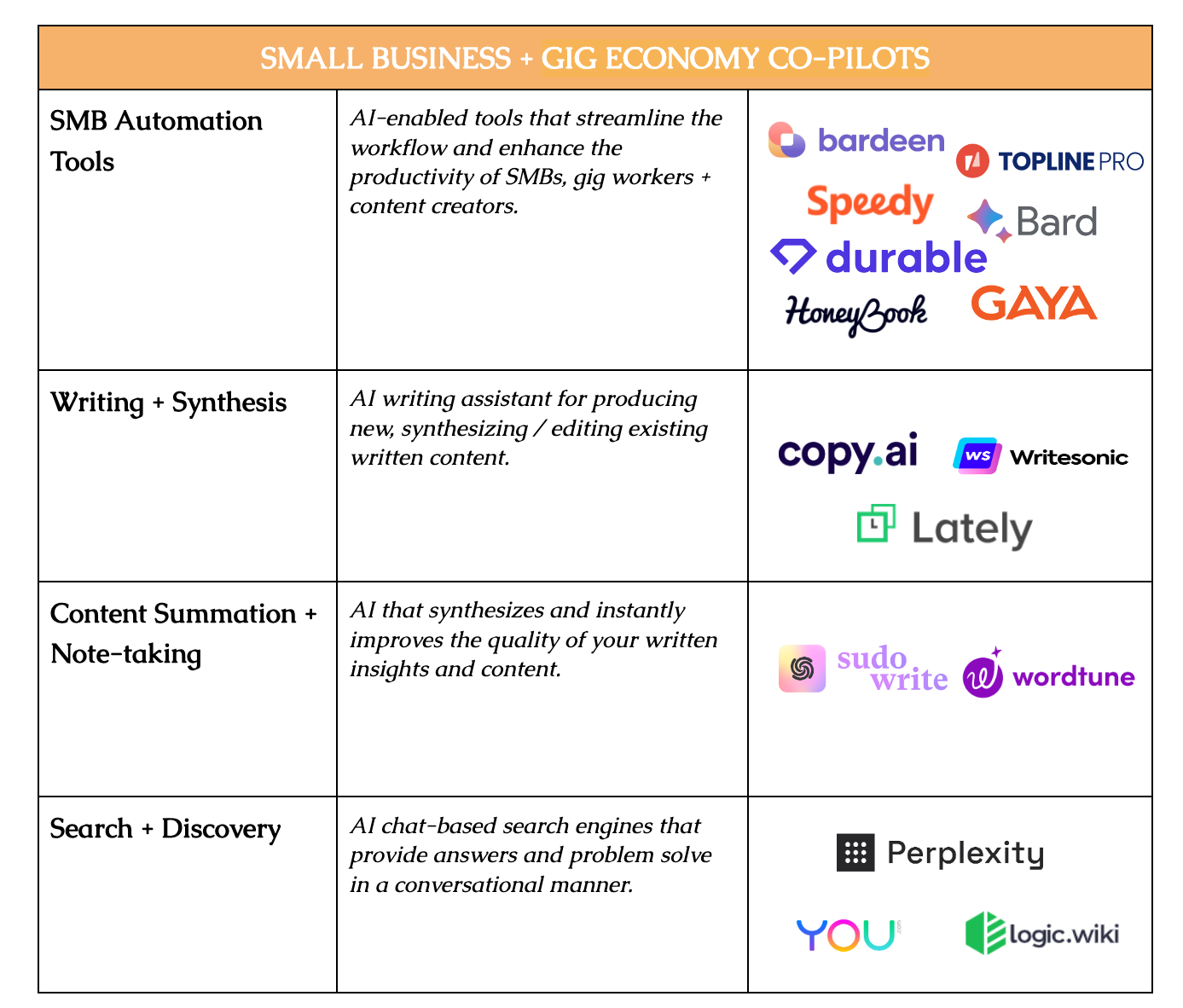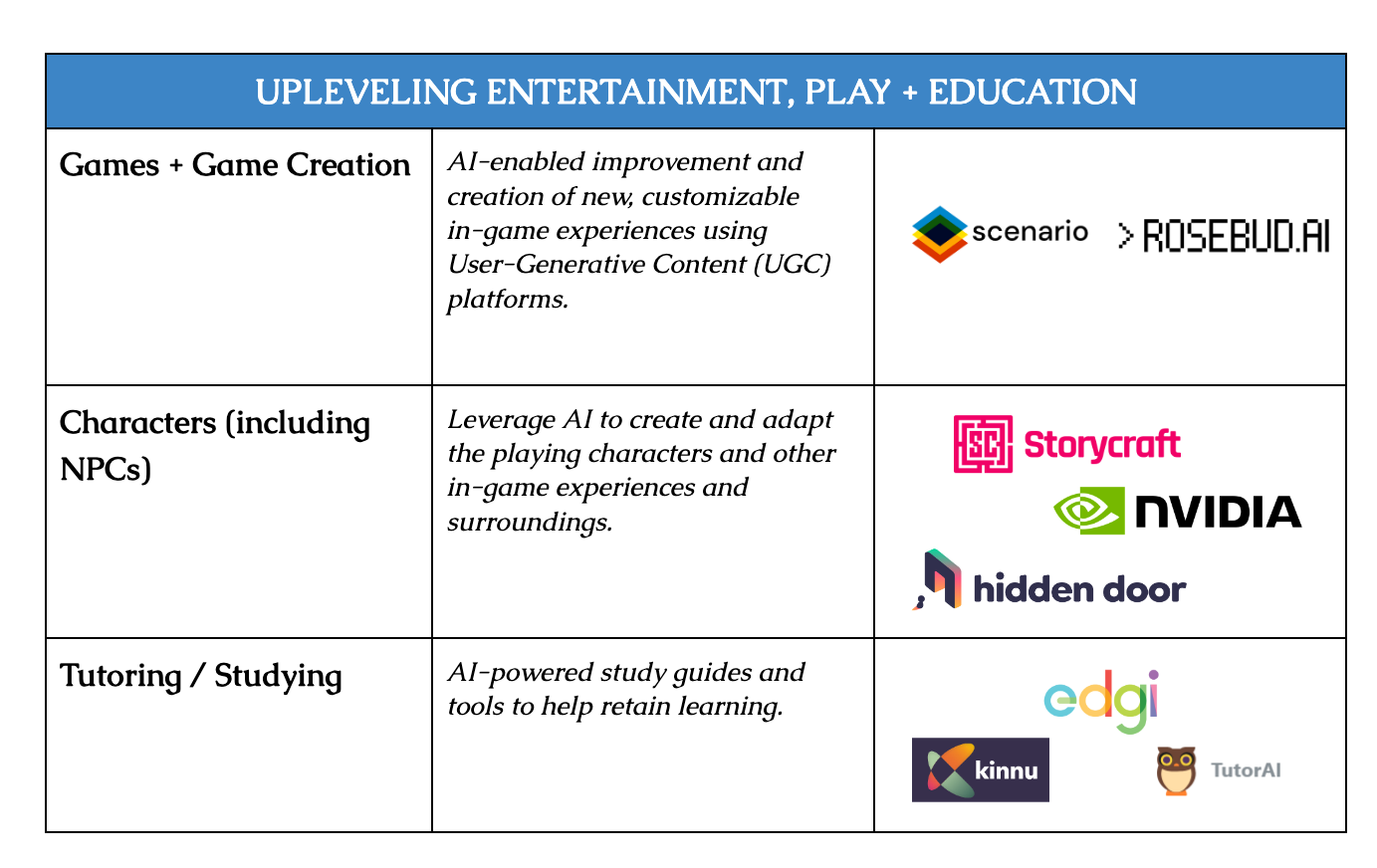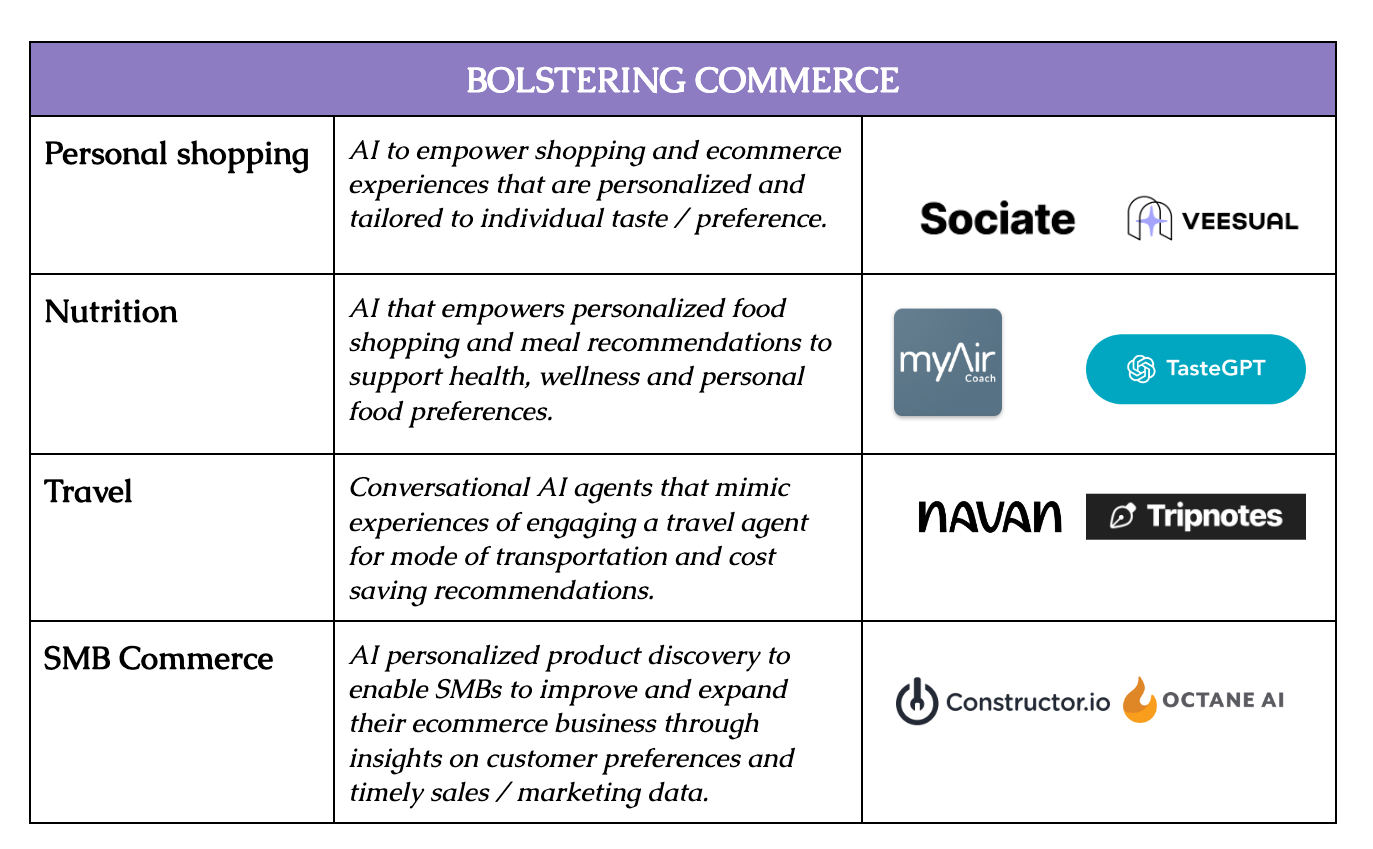The Next Era of Consumer Generative AI: Perspectives From Top VCs, Operators, and Founders
Highlighting the considerations and interest areas dozens of top leaders have shared with us, as well as some of the trends that led to generative AI’s rise in the public consciousness of consumers.

At Primary, we’re interested in backing top Founders building generation-defining experiences for consumers. As the earliest backers of Coupang, Jet.com, Slice, and K Health, we’ve always aimed to find what is next for consumers.
With the prolific impact of Generative AI on the tech ecosystem, we’re seeing a surge of builders here in NYC and across the country building in this space from many angles. At the same time, early data on VC investments in Q3 2023 funding suggest that what many called a generative AI funding hype cycle may be waning slightly. However despite concerns about high valuations and the difficulties of building a competitive moat at the application layer, consumer interest in utilizing a variety of use cases persists. Almost a year after ChatGPT’s game-changing launch, examples of this virality continue to surface, as recently as as photo editing app Epik reaching #1 in the App Store this month. So what is keeping generative AI to the center of public consciousness, what use cases are here for now vs. here to stay, and what does this mean for founders, investors and ultimately consumers? As part of our research into this tidal wave of interest, we spent the last quarter digging into the trends that have led us to this inflection point and the use cases that have emerged by uncovering the points of view of top VCs, Founders, and academics. By sharing our emerging thinking and a roundup of perspectives, we aim to help advance the thinking and language surrounding the market and its impact on consumers for founders and operators alike.
Unpacking the research breakthroughs, creation shifts and cautionary tales around the rise of generative AI in the public consciousness
Technological breakthroughs that ripple throughout the tech ecosystem, impact the public markets, and wow the everyday consumer have come about nearly once every few decades. From the advent of the desktop personal computer, to the introduction of the internet, to the shift to mobile technology, these platform shifts are few, far between, and vastly consequential for society at large. At its core, what a platform shift signifies is simple—democratization of access to a new tier of experiences, connectivity, and information at a much lower cost.
ChatGPT’s record-breaking rise to 1 million users in five days was AI’s “iPhone moment”. Leaders such as Rachel Woods, Founder of the AI Exchange agree that generative AI technology is exciting in large part because of the accessibility that it creates, benefiting businesses and consumers alike. “Prior to generative AI and foundation models, you would need significant investments of time, money and talent to build AI into your business or product. Now, it’s as simple as describing what you want”.
This opportunity to provide a new tier of experiences to consumers has been accelerated by major advances in the last five to six years in particular, including significant breakthroughs such as the introduction of revolutionary transformer architecture. In essence, these breakthroughs have become the foundation for this wave of generative AI by making the variability of applications possible, from image generation, to text analysis and even consumer use cases such as personalized commerce, learning, and entertainment. “Generative AI will enable so many innovations on how we produce new things. The assembly line behind creating a product or service or something new will also change as a result”, notes Professor Dan Wang of Columbia Business School.
Notably - alongside this excitement, we’re seeing many investors, founders and experts who actively seek to invest in, build and join these new companies balance their excitement around the opportunity with cautious optimism due to lessons learned from hype cycles we’ve seen in the past. “What's exciting, relative to web3 and a few other hype cycles in recent memory, is that there are a bunch of products getting real engagement and usage, real revenue, and growing quickly”, notes Nikhil Basu Trivedi, Co-Founder and General Partner at Footwork. He points to ChatGPT and MosaicML as strong product examples; he also cautions that “just because a company is building in generative AI, doesn't mean that it deserves a valuation well ahead of its fundamental progress as a business”.
This reminder is a perspective shared by many across the ecosystem and is worth paying attention to, alongside additional considerations related to data privacy-focused regulations and warranted concerns around what constitutes ethical usage of generative AI technology. And still, at Primary we believe that thoughtful use of this technology continues to present boundless opportunities for consumers. We’re excited to unpack some of the use cases as we collectively navigate the early stages of what is perhaps the biggest technological advancement we’ve seen in a generation.
Understanding the broader trends that paved a path for this moment
At a broader level, three interrelated trends in particular have served as tailwinds to pique the excitement of consumers interested in leveraging the technology for work, play, and increased productivity in our personal lives:
Increased significance of content and knowledge generation
Instagram, TikTok, and X/Twitter have deeply engrained a new medium for social branding and knowledge sharing in our brains that existed in a very different way from previous generations.
Content and knowledge generation underpins the “influencer” status that can be gained by being an elite creative or intellectual across different categories. And consumers are leaning into this shift in how they consume content; 40% of Gen Z use TikTok or Instagram to search for product and service recommendations instead of Google. AI has made it easier than ever to share information that connects with an audience and builds community. The interactive nature of generative AI technology increasingly presents an opportune leverage point for learning and education for Gen-Z and beyond. A survey of 2K+ Gen Zers recently noted that 24% of respondents currently use this technology to aid in their homework, and a recent Redpoint survey notes that learning methods that are engaging and facilitate entertainment are increasingly important to this generation.
The rise of knowledge work and the need for more productivity
Knowledge workers are increasingly well-positioned to increase their productivity by leaps and bounds with the support of AI tools. According to Goldman Sachs, workers at firms that have been early to adopt AI are poised to add 2-3 years of productivity per person, per year. Furthermore, by 2030, 30% of the hours that are currently spent in the U.S. economy might be automated through AI, mostly by speeding knowledge workers’ output. The increased accessibility of these tools allow us to not only work hard, but to also work smart with efficiency. With a renewed focus on the financial health and capital efficiency of businesses both large and small, employees and management alike want to find ways to streamline their day-to-day work and lives.
Increased connectivity needs of consumers
The COVID-19 pandemic exacerbated a need for leveraging digital spaces and technology platforms to create connections across silos both online and in-person. Between 2003 and 2023, the U.S. Surgeon General’s Advisory Team reported that social isolation increased an average of 24 hours /month, and social engagement with friends decreased by 20 hours/ month. As social media continues to both incentivize content creation behavior and make people feel more lonely, it’s no surprise that a number of the strengths of AI tools are well aligned with an increased interest from consumers in leveraging technology to create and maintain communities.
Creativity, co-pilots, companionship and more —the consumer generative AI use cases democratizing access for all
One of the clearest strengths of generative AI technology today lies in its ability to assist consumers in generating new and interactive content, unleashing a different level of productivity/output, and creating a different level of personalization based on one's own knowledge base and personal preferences. With the plethora of consumer use cases made possible by advancements in generative AI technology, we’re excited about use cases that are leveraging these advanced capabilities to democratize access to information, insights, and productivity enablers while improving the experience to do so tenfold. We believe the best investments will come from deeply personalized experiences or new consumer concepts that have inherent network effects. Many of these new products, whether investable or not, will change consumer experiences forever. Here are some use cases we’ve seen of late that are likely to define the future we live in:
Enabling human-like interaction
From products enabling communication with others through a personalized likeness model (Personal AI), to products facilitating connections with companions (Daimon Labs) to products focused on communication in support of one’s mental health (Mendora), we’re excited about use cases that offer low-cost opportunities to mimic human interaction and leverage personal connection to retain memories, build connections, and surface helpful and individualized insights to improve lives.

“While generative AI has made significant strides, especially in language and content, we're still largely operating within the same platforms. We remain entrenched in the creator economy, where content is produced for consumption. However, with the rise of Personal AI, we're beginning to diverge from this model. Instead of focusing on content for mass consumption (user generated content), Personal AI emphasizes the idea of personal intelligence (user generated models)...the hope is that generative AI will pave the way for creators to truly own and control their creations."
— Jon Bikoff, Personal.ai
“Generative AI models will fundamentally change our relationship with computers, putting them beside us as coworkers, friends, family members, and even lovers. Most of the attention around LLMs thus far has focused on how they’re automating more traditional tasks—like customer support, research, document drafting, and summarization—but when you look at what’s driving emergent consumer use cases and excitement, AI companionship leads the way.”
—Justine Moore, Bryan Kim, Yoko Li, and Martin Casado, a16z (source)
“Information overload is a major problem in modern day society. LLMs have the power to execute on what companies like Neuralink will aim to do, putting both new and old information at the fingertips of consumers, but with a very different interface. Technology advancements over the course of human history aim to make society more productive and I believe that consumer AI companies are ready to empower us in a way that we have not experienced since the rise of mobile & search. Products that make us feel more connected to our knowledge and network are ripe to make an impact.”
-Jason Shuman, Primary
Improving content creation + creativity
From moving from text to audio (Murf.ai), to editing photos (Imagen AI), to digital identity /fan engagement (Pendium.ai), we’ve enjoyed leveraging tools that reduce time and cost for consumers in a way that is low cost and high value to them while maximizing their delight.

“At GC, we are beyond excited to invest in GenAI tech founders who can help truly unlock human creativity across multiple use cases. If the iPhone is the modern day calculator (i.e. left brain), GenAI products will give all of us right brain superpowers. The combo will be extremely powerful.”
—Niko Bonatsos, General Catalyst
“We went from desktop first, to mobile first, and now to audio first. AI makes it easier to organize information, package it and share it. At the same time we've seen a massive proliferation of podcasts in the last 8 years. As well as Airpods, double speed YouTube, Whatsapp, Netflix, & Spotify. Airpods are likely to get LTE connectivity soon. I'm particularly excited about the crossover between audio and AI.”
— Cliff Weitzman, Speechify
“I'm very interested in the intersection of generative AI and creative tooling. We've seen Runway launch impressive products around video (check out Gen-2 here), Alpaca bring superpowers to photoshop, and Wand make anyone able to create professional-looking art. Generative AI extends what humans are capable of, including in creative expression. We've also seen incumbents like Adobe and Canva move quickly; a key question here will be the classic startup question, "Can startups acquire distribution before incumbents acquire innovation?" The optimistic view for startups is that they're agile, flexible, and moments of major change (like this platform shift) have historically led to an Innovator's Dilemma and new company formation.”
—Rex Woodbury, Daybreak
“I am excited about technologies which allow creators to convert their audio and visual content into any language by still using the creators voice. In our previous thesis work, we highlight consistently that if this comes to fruition, it will allow all creators to be global from day one unlike today, where creators can only be so global in their spoken language.”
— Ollie Forsyth, Antler
Small business + gig economy co-pilots
From copywriting (Copy.ai), to content summation (Mem.ai), and even verticalized back office automation (Gayafi), we buy into a future where products create 10X output for time-strapped freelancers and SMBs, particularly in areas where business growth, back office automation, and content creation have clear ways to be automated. We see incredible opportunity to bring these tools to the more than 33 million small businesses in the U.S. who will gain dramatic improvements in their quality of life by embracing these automations in their workflows. As a result, tools such as ToplinePro, which look to help drive revenue in a vertical focused manner, leading to better lives for SMB owners, are quite appealing to us.

“GenerativeAI is about to be a gamechanger for the small business owners. Advancements will help SMBs get work, do work and get paid in ways they have not experienced before unless they’ve leveraged BPOs or 3rd party agencies. Not only is it about giving people time back, but it will help them grow their business in a big way as well. I get most excited by startups who are helping SMBs and SMEs grow their business in an automated way or have an incredibly clear ROI when it comes to the time savings on the doing work side of things. This includes things like vertical focused back office automation that requires specific workflows that would be challenging to attack by horizontal players.”
—Jason Shuman, Primary
"With advancements in AI propelling forward significant changes far and wide, we believe that new technologies will continue to reshape the labor market as we know it. As white collar jobs become increasingly automated, the need for full-time, permanent employees in today's prototypical employment fields will likely continue to decline. Instead, while some workers will elect to work on a contract basis for more traditional employers, others are likely to find themselves exploring more entrepreneurial opportunities as the technology displacing them similarly enhances their operational toolkits as owner-operators.”
—Meera Clark, Redpoint Ventures
“As a global investor, the use cases that make me most excited are the ones supporting economic opportunity for communities and users who have been often left behind within the tech industry. Generative AI is becoming a force multiplier for small business owners and their small teams around the world—from writing code and building functional web apps to handling customer service conversations across language barriers to drafting marketing materials and communications to creating finance budgets and legal documents. Small mom and pop shop owners in rural communities and emerging markets around the world can finally benefit from accessible technologies to accelerate economic development from Louisville to Lagos.”
—Jason Scott, Anim Fund
“We’ve gone through four phases around generative AI; after the first wave of shock, the second wave of concern around public data, and the third around figuring out how to customize tone of voice, we’ve reached a fourth wave focused on prompt expertise. We’re seeing that in job descriptions, people are trying to figure out a substantial amount of human capital that needs to be invested to use this technology, as sentient AI does not yet exist. Overall, people are realizing what you can generate is only as good as what you put in. So we built a continuously learning performance loop that updates in real time, all the time, constantly tying your results to relevant data – as opposed to pulling it out of thin air; this allows us to reveal the ideas, phrases and keywords you need to include in the content you're generating to get your unique audience to like, comment, share and engage with your content.”
— Kate Bradley Chernis, Lately.AI
Upleveling entertainment, play, and education
From games / game creation (Rosebud.ai), to characters / roleplaying (Hidden Door), we’re seeing a rise in entertainment + play use cases that put consumers in the driver's seat of how they engage in play and create a world that entertains and can make learning enjoyable.

“NPCs / bots in platforms even outside of games like in Discord have become so impressive that you can now create a bot/mascot with the exact personality of the server you're interested in. If integrated in consumer experiences normally, I think social games and communities can be jump-started with bots since they've become indiscernible. This is why I'm excited about companies like Circle Labs.”
—Lia Zhang, the Makers Fund
“I like to invest in areas ripe for democratization, and AI is a force multiplier. Education and health are especially well primed for massive change. The last great tech wave increased access and ease, but AI can uncover a level of personalization that yields high value to an individual while simultaneously building defensibility for companies. From health data, customized medicine, and preventative care to course content generation and personalized learning, it's easy to see a future where we are even more informed, empowered, and enriched.”
—Elizabeth Weil, Scribble VC
"As LLMs evolve to better understand and interact with multiple modalities, they’ll be able to offer more engaging, connected, and comprehensive experiences to consumers, who will be able to engage outside of a chat interface..from video chats with AI tutors to iterating and writing TV pilot scripts with an AI partner, multimodality has the potential to change entertainment, learning and development, and content generation across a variety of consumer and enterprise use cases.”
—Sarah Wang and Shangda Xu, a16z (source)
“AI can be a powerful tool, but it's not a magic bullet. The success of an edtech business depends on its ability to create products that people love and that solve real problems for students, teachers and workers. If your offering is unparalleled because you understand your end users better than anyone else and create end user value, AI will only amplify your product.”
—Claire Zau, GSV Ventures
Bolstering commerce
From use cases across personal shopping (Octane AI), Nutrition (MyAir), and Travel (Tripnotes), we find use cases fascinating that leverage improved pattern recognition to personalize consumer purchasing experiences or optimize the ability for SMBs to use the technology for product discovery.

“AI is already powering everyday consumer products, from Uber to TikTok, so the question is where will Generative AI in particular create disruptive innovation in consumer? With Gen AI, we can create dynamic conversational interfaces, deeper personalization, delightful task automation and creative flow. I'm most bullish on new generational products emerging in:
- Search
- Productivity co-pilots
- Self-expression and digital identity
- Personalized commerce
It's still early so what comes next is as much a function of founders' imagination as the tech itself.”
—Ann Bordetsky, NEA
“I'm excited to see more AI companies reinventing commerce, especially enabling conversational commerce and personalizing the shopping experience. Consumers are looking for tools and platforms that make ecommerce more digestible.”
—Sydney Sykes, Lightspeed Venture Partners
Expanding fintech
While fintech is a tricky use case for generative AI due to the critical nature of accuracy for outputs, we’re excited to see a blend of traditional and generative AI technologies surfacing to address consumer needs, particularly across personalized financial advice and support (StockGPT). Other use cases we anticipate will see increased opportunity include fighting bills, financial advisor co-pilots, and improved banking chatbots.

“While consumer fintech companies have achieved an enormous amount of success over the past 10 years, they haven’t yet fulfilled their most ambitious promise: to optimize a consumer’s balance sheet and income statement, without a human in the loop. This promise remains unfulfilled because user interfaces are unable to fully capture the human context that influences financial decisions or provide advice and cross-selling in a way that helps humans make appropriate tradeoffs…LLMs provide a tidy solution to these problems with a better understanding and thus a better navigation of consumers’ financial decisions. These systems can answer questions (“Why is part of my portfolio in muni bonds?”), evaluate tradeoffs (“How should I think about duration risk versus yield?”), and ultimately factor human context into decision making (“Can you build a plan that’s flexible enough to help financially support my aging parents at some point in the future?”). These capabilities should transform consumer fintech from a high-value, but narrowly focused set of use cases to another where apps can help consumers optimize their entire financial lives.”
—Anish Acharya and Sumeet Singh, a16z (source)
“Tax, Security, Insurance, and healthcare use cases are all the most interesting because these categories make up a disproportionate amount of US GDP but still have an inordinate amount of open job vacancies/listings.”
—Heston Berkman, Banter Capital
“37% of financial advisors representing approx. 40% of the industry’s assets plan to retire in the coming decade. This is in addition to the many consumers who already can’t afford to access personalized financial advice. Generative AI has the opportunity to democratize access to financial planning whether that is by helping human advisors scale to grow their client bases or powering new interfaces to help consumers make the best decisions at critical junctures (e.g. signing for student loans, starting to plan for retirement).”
—Emily Man, Primary
We’re only just beginning: a preview of part 2
Generally, we’re excited about the exponential growth opportunities for companies building to address critical consumer pain points while also creating delight for consumers in a way that increases their productivity, all at low cost to them. The market forces around consumer behavior at home and at work have shaped a powerful opportunity for early stage builders. Guided by the vision of founders who take an expansive and intentional approach to their model selection, team build and UX/UI, generative AI technology has the potential to greatly democratize access to tools and experiences for consumers to learn, work, play, engage in commerce and engage one another. The sky truly is the limit, and we believe we’ve only scratched the surface of new use cases and interfaces that will be embedded in our day-to-day lives in the future.
To leverage a baseball analogy, we’re only in inning 1 of the first game in the broader context of generative AI’s impact on the future of technology as we know it. So how do you parse out the best from the rest? Stay tuned for Part 2 of this series, in which Jason Shuman and I will dig in further to provide emerging frameworks for how to assess which use cases, companies and dynamics are best set up for success and longevity with consumers.